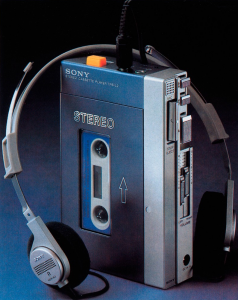
Music on the move – thanks to the opera-loving chairman
Created to answer a personal request of the honorary chairman, deemed unlikely to sell because it lacked a key product feature, with a name that senior management actively disliked, it went on to be a worldwide success that has helped shape the music industry, selling millions and millions of units worldwide. The name, like Hoover or Sellotape, came to define the category and is listed in the Oxford English Dictionary.
The brand is Sony Walkman.
Sony introduced the Walkman in 1979 but its origins can be traced back well before then.
In the 1950s the first portable cassette recorders came onto the market but, like many hi-tech products, they were targeted at a professional market and not the general public. The main users were journalists who could afford the high prices for the equipment and the specialised micro-cassettes, which at the time weren’t used in the music industry. Sony called theirs Pressman.
In 1962, Philips invented what became known as the Cassette tape, though it was more formally labelled and trademarked as a Compact Cassette. Philips’ subsequent decision, interestingly in the face of pressure from Sony, to license the format free of charge led it to become the dominant tape in the market.
1964 saw both the introduction of the first pre-recorded music cassettes and Philips Norelco Carry-Corder 150 portable recorder/player. By 1968, 85 manufacturers had sold over 2.4 million players despite the sound quality being only mediocre.
The quality improved dramatically by the early 1970s and the Compact Cassette went on to become increasing popular especially as it provided the ability to re-record.
 In 1978, Sony launched the TC-D5 a portable cassette player and, while general sales were limited due its high price, the lack of suitable lightweight headphones and its relatively large size, it did become a favourite amongst many of the senior people in the Sony company due to its high quality sound.
In 1978, Sony launched the TC-D5 a portable cassette player and, while general sales were limited due its high price, the lack of suitable lightweight headphones and its relatively large size, it did become a favourite amongst many of the senior people in the Sony company due to its high quality sound.
One regular user was Masaru Ibuka, co-founder and then Sony’s honorary chairman. He used the player to listen to operas on his many airplane trips, but he still found the player too heavy for everyday use. He instructed the tape recorder division to create a smaller version for his personal use.
The division, led by Kozo Ohsone, modified a Pressman to do the job. They removed the record function and added stereophonic sound. Ibuka was immediately impressed and suggested that they bring a similar item to market.
It was a well-timed suggestion, Sony’s tape recorder division was flagging. So it was that in February 1979, Akio Morita, the company’s other co-founder, demanded that the engineers develop a player similar to the one they had developed for Ibuka but it had to be more commercially viable. He also told them that he wanted the product by June 21, 1979.
With that demand ringing in their ears and worried that the division would be consolidated into another one if they failed, the engineers went to work. They took a pragmatic approach and designed a portable tape player based on Ibuka’s modified Pressman player but using lower end components to bring the price down and encasing it in a small, stylish enclosure.
There was still the problem of the headphones. The current ones were far larger than the new player itself, they weighed more than 400 grams.
 Luckily for the team, three years before, engineers in another division had designed a lightweight pair of headphones. They eliminated the large, enclosed earpiece and in its place put soft foam. They weighed in at around 50 grams. They were quickly added to the new design.
Luckily for the team, three years before, engineers in another division had designed a lightweight pair of headphones. They eliminated the large, enclosed earpiece and in its place put soft foam. They weighed in at around 50 grams. They were quickly added to the new design.
The device now needed a name. “Walkman”, a variation on the Pressman was suggested. It is said that Morita hated the name “Walkman” and feared it would not catch on in the US and Europe.
Alternatives, like “Walky”, “Freestyle” and “Soundabout” were considered, and even tried in other countries, but ultimately the name Walkman stayed.
Having met the deadline, Sony announced their new product to the trade press on July 1st 1979 – a truly personal and truly portable 14 ounce, blue-and-silver cassette player with chunky buttons, headphones and a leather case. It also had a second earphone jack so that two people could listen in at once.
The reaction wasn’t encouraging. Some claimed that nobody would be interested in a tape player without a record function. Others pointed out that the most popular tape recorder of the time had sold less than 15,000 units, yet Sony had produced 30,000 units.
Sony however decided to press on and the Walkman was announced to the public.
It was the right decision.
A month after the Walkman became available in Japanese stores, it was sold out.
It went on to be a success right around the world. In the next decade, Sony sold 50 million units, and competitors who copied the idea sold millions more.